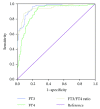Diagnostic Values of Free Triiodothyronine and Free Thyroxine and the Ratio of Free Triiodothyronine to Free Thyroxine in Thyrotoxicosis
- PMID: 29971103
- PMCID: PMC6008621
- DOI: 10.1155/2018/4836736
Diagnostic Values of Free Triiodothyronine and Free Thyroxine and the Ratio of Free Triiodothyronine to Free Thyroxine in Thyrotoxicosis
Abstract
Background: The results of previous studies on the usefulness of free triiodothyronine (FT3) to free thyroxine (FT4) are controversial. We investigated the usefulness of FT3, FT4, and FT3/FT4 ratio in differentiating Graves' disease (GD) from destructive thyroiditis.
Methods: A total of 126 patients with untreated GD, 36 with painless thyroiditis, 18 with painful subacute thyroiditis, and 63 healthy controls, were recruited. The levels of FT3 and FT4 and the FT3/FT4 ratios for the different etiologies of thyrotoxicosis were evaluated separately by receiver operating characteristic (ROC) curve analysis. The expression levels of type 1 and type 2 deiodinase (DIO1 and DIO2) in thyroid tissues were also investigated.
Results: The optimal cut-off values were 7.215 pmol/L for FT3, 21.71 pmol/L for FT4, and 0.4056 for the FT3/FT4 ratio. The specificity and positive predictive value of the FT3/FT4 ratio were highest for values > 0.4056. DIO1 mRNA expression was significantly higher in the thyroid tissue of patients with GD (P = 0.013).
Conclusions: We demonstrated that the FT3/FT4 ratio was useful in differentiating GD from destructive thyroiditis. In addition, a relatively high expression of type 1 deiodinase in the thyroid might be responsible for the high FT3/FT4 ratio in patients with GD.
Figures




Similar articles
-
Ratio of serum free triiodothyronine to free thyroxine in Graves' hyperthyroidism and thyrotoxicosis caused by painless thyroiditis.Endocr J. 2005 Oct;52(5):537-42. doi: 10.1507/endocrj.52.537. Endocr J. 2005. PMID: 16284430
-
Free triiodothyronine to free thyroxine ratio in the differential diagnosis of thyrotoxicosis and hyperthyroidism: A retrospective study.Int J Clin Pract. 2021 May;75(5):e14003. doi: 10.1111/ijcp.14003. Epub 2021 Jan 21. Int J Clin Pract. 2021. PMID: 33403716
-
Simple and practical parameters for differentiation between destruction-induced thyrotoxicosis and Graves' thyrotoxicosis.Clin Endocrinol (Oxf). 2002 Jul;57(1):51-8. doi: 10.1046/j.1365-2265.2002.01558.x. Clin Endocrinol (Oxf). 2002. PMID: 12100069
-
Effect of traditional Chinese medicine on Graves' disease: a network meta-analysis.Front Pharmacol. 2024 Aug 22;15:1411459. doi: 10.3389/fphar.2024.1411459. eCollection 2024. Front Pharmacol. 2024. PMID: 39239642 Free PMC article.
-
Could effective iodine-131 half-life be extended by lithium carbonate in Graves' disease patients: Results from a retrospective analysis.Biomol Biomed. 2024 Oct 17;24(6):1711-6. doi: 10.17305/bb.2024.10659. Biomol Biomed. 2024. PMID: 38889393 Free PMC article. Review.
Cited by
-
Establishing a diagnostic scale of subacute thyroiditis without radioisotope scanning.BMC Endocr Disord. 2020 May 27;20(1):74. doi: 10.1186/s12902-020-00554-z. BMC Endocr Disord. 2020. PMID: 32460870 Free PMC article.
-
Assessment of the Relationship Between Genetic Determinants of Thyroid Function and Atrial Fibrillation: A Mendelian Randomization Study.JAMA Cardiol. 2019 Feb 1;4(2):144-152. doi: 10.1001/jamacardio.2018.4635. JAMA Cardiol. 2019. PMID: 30673084 Free PMC article.
-
Severe radiation thyroiditis after radioactive iodine for treatment of Graves' disease.Singapore Med J. 2021 Sep;62(9):486-491. doi: 10.11622/smedj.2020039. Epub 2020 Mar 31. Singapore Med J. 2021. PMID: 32227795 Free PMC article.
-
Establishment of Reference Intervals for Serum Thyroid-related Hormones in the Chinese Oldest-old.Int J Med Sci. 2025 Apr 28;22(10):2408-2418. doi: 10.7150/ijms.109606. eCollection 2025. Int J Med Sci. 2025. PMID: 40386060 Free PMC article.
-
Thyroid hormone sensitivity and diabetes onset: a longitudinal cross-lagged cohort.Front Endocrinol (Lausanne). 2023 Oct 16;14:1267612. doi: 10.3389/fendo.2023.1267612. eCollection 2023. Front Endocrinol (Lausanne). 2023. PMID: 37908753 Free PMC article.
References
LinkOut - more resources
Full Text Sources
Other Literature Sources

